

Global Manufacturing Rebound Could Signal a Bright Year for Copper
Copper was one of only two metals that finished 2023 in the black, gold being the other metal. The asset flashed a bullish “golden cross” signal, with the 50-day moving average jumping above the 200-day moving average, and prices currently look stable in the $8,400-$8,600 per metric ton range.
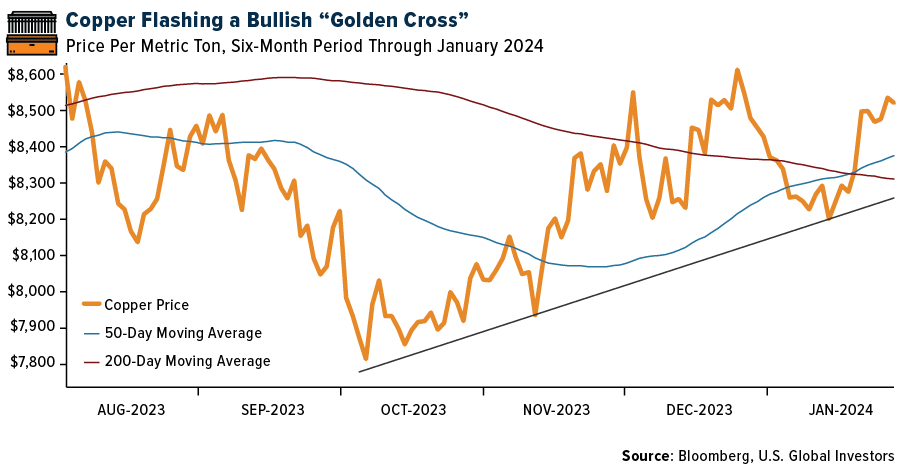
Some industry leaders are anticipating lofty gains in the coming months. The billionaire founder of Ivanhoe Mines, Robert Friedland, has forecast a potential surge in copper prices to $9,500 a metric ton this year. This bullish call is underpinned by a combination of lower interest rates later in the year and a ramp-up in demand from China, which Robert stresses has not slowed its consumption of the red metal, despite its shaky real estate market. The country, in fact, bought more copper in 2023 than in any other year on record, importing 27.54 million tons.
“Everybody knows about the weak real estate market in China… but military demand, national security demand, [and] demand for militarization is very high,” Robert told Bloomberg TV last week.
This, I believe, will more than offset the sluggishness in copper demand from Chinese property developers. (And for what it’s worth, Reuters reports today that the country’s property sector is showing signs of recovery, with new home prices rising at the fastest pace in two and a half years and government land sales finally turning positive after 23 months.) China’s recent move to pump about 1 trillion yuan ($140 billion) into its economy acts as a further catalyst, promising to boost copper demand.
Copper as a Preferred Transition Metal
Copper’s allure, however, isn’t just a product of market speculation. It’s rooted in its critical role in powering the green transition. In 2023, renewable energy contributed an unheard-of 11.4 trillion yuan ($1.6 trillion) to China’s economy, more than any other sector, according to a report by the Centre for Research on Energy and Clear Air (CREA). The Asian giant invested $890 billion in clean energy technologies last year, similar in size to the GDPs of Switzerland and Turkey.
While the mining sector often finds itself at the crossroads of environmental debates, copper emerges as a more favorable bet, I believe, than traditional transition technologies like wind and solar. This is particularly notable considering the red metal finished last year with a slight increase of 1.2%, while the S&P Global Clean Energy Index sank over 21%.
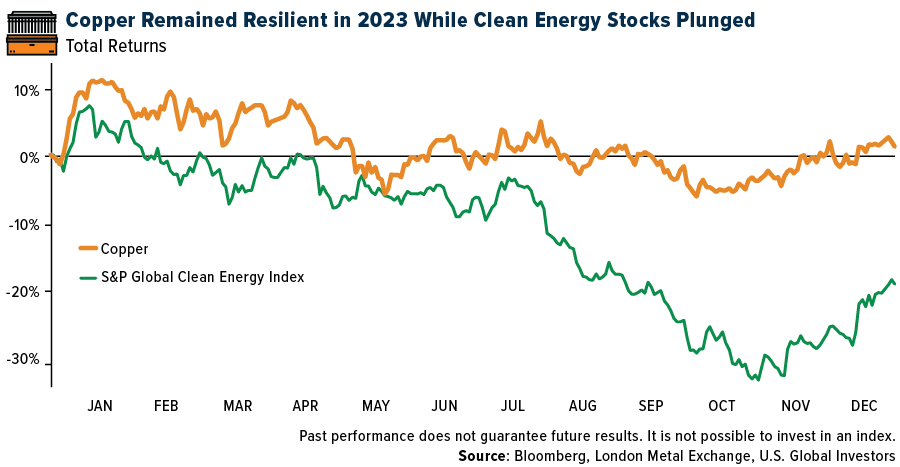
In addition, the global economy appears to be on surer footing than many anticipated. With the rate of inflation on a downward trajectory, we’re likely to see a softening of interest rates by the Federal Reserve by midyear at the latest. This economic environment bodes well for industries reliant on copper, including automotive and consumer goods manufacturing.
Global Manufacturers on the Mend
The global manufacturing sector is also showing signs of a pulse. The JPMorgan Global Manufacturing PMI hit the neutral 50.0 mark in January, halting a 16-month streak of sub-50 readings. This suggests a stabilization in global manufacturing—a critical user of copper. You can watch my explainer on the relationship between the Global Manufacturing PMI and commodities demand by clicking here.
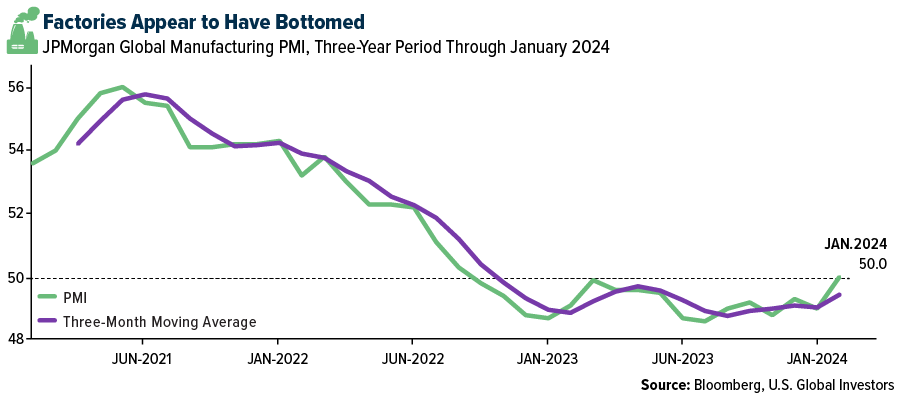
U.S. manufacturers kicked off the year with renewed optimism and an uptick in demand. The S&P Global US Manufacturing PMI climbed to 50.7 in January, its highest level since September 2022. This positive shift was attributed to easing inflation and more accommodating financial conditions, alongside an increase in production and payroll numbers.
The Institute for Supply Management (ISM) Manufacturing PMI, on the other hand, showed that U.S. factories were still in contraction mode, but only barely. The Manufacturing PMI registered 49.1 in January, up from 47.1 in December and marking the 15th straight month that the reading was below the 50.0 threshold.
More Than a Metal
The confluence of economic resilience, burgeoning demand from key sectors and a revitalization in global manufacturing paints a compelling picture for copper in 2024. I’m convinced that the metal is poised not just as a metal of historical significance but as a pivotal element in driving forward the next phase of economic and technological progress. In this sense, copper is not merely a commodity; it’s a catalyst for a new era of global economic growth.

Index Summary
- The major market indices finished mixed this week. The Dow Jones Industrial Average gained 1.43%. The S&P 500 Stock Index rose 1.38%, while the Nasdaq Composite climbed 1.12%. The Russell 2000 small capitalization index lost 0.79% this week.
- The Hang Seng Composite gained 18.13% this week; while Taiwan was up 0.36% and the KOSPI rose 5.52%.
- The 10-year Treasury bond yield fell 11 basis points to 4.025%.
Airlines and Shipping
Strengths
- Shares of American Airlines rose around 1.5% to start the week, reports Investing.com, after the stock received an upgrade from Citi analysts from neutral to buy and raised the target price from $15.13 to $20. Analysts at Citi said North American network carriers seem better positioned in the post-pandemic landscape due to their diversified sources of revenue and strong demand for premium cabin services, the article explains.
- Sun Country Airlines soared as much as 12% this week, the most intraday since November 2022, after the carrier reported adjusted earnings per share (EPS) for the fourth quarter that surpassed the average analyst estimate.
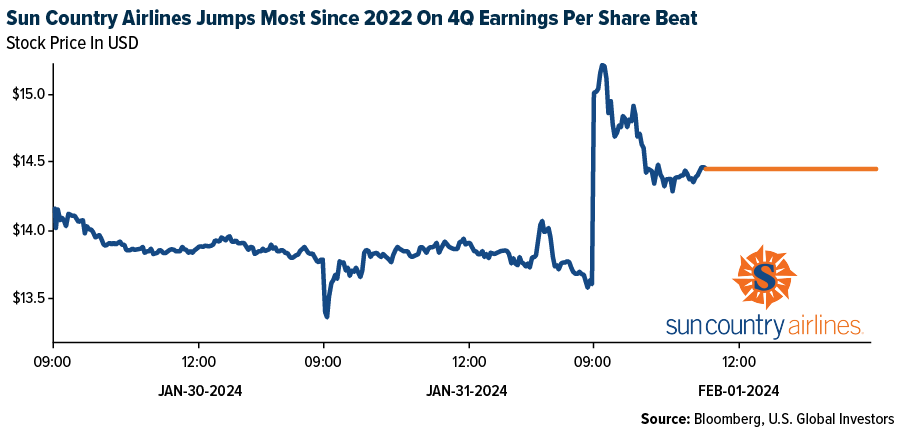
- JPMorgan analyst Harry Gowers raised the recommendation on EasyJet to overweight from neutral. The price target, raised to 690 pence, implies a 24% increase from the last price, writes Bloomberg.
Weaknesses
- Oman’s exports of crude and condensates dropped to an eight-month low in January due to reduced shipments to China. Overall observed volumes dropped to 919,000 b/d last month, according to tanker-tracking data compiled by Bloomberg.
- Kuwait’s observed crude exports slid to a five-month low in January with cargoes bound for China set to plunge to the lowest in several years. Shipments to China, usually the biggest buyer of Kuwaiti crude, more than halved to just 161,000 b/d in the provisional data, writes Bloomberg.
- Hong Kong’s much boasted $18.1 billion airport expansion has been delayed until at least the end of 2025, writes Bloomberg, a blow to the Asian financial hub’s post-Covid economic revival. Originally due to be completed by the end of 2024, part of the second terminal development will now not be ready for another year at least.
Opportunities
- Integrated logistics company A.P. Moller-Maersk announced Monday the appointment of Charles van der Steene as its new Regional President of North America, effective February 1. A logistics industry veteran, van der Steene joined Maersk in 2011 with deep global experience in commercial leadership, operations, and general management. “North America is our number one market, and Charles takes helm of a very well-run organization,” Maersk CEO Vincent Clerc commented.
- American Express and Delta Air Lines are revamping their co-branded credit cards to offer new rewards and benefits that target both restaurants and trips through ride-share services, writes Bloomberg.
- Istanbul Airport operator IGA will start using three runways at the airport this year, helping it reach 200 million passengers per year without having to build three more runways as part of Phase 5 of the project, writes Bloomberg.
Threats
- Attacks by Houthi militants on merchant ships are boosting the price of diesel in Europe. Since the start of the year, the wholesale cost of fuel delivered into northwest Europe has jumped by 12% to just over $116 per barrel, writes Bloomberg.
- A small plane crashed and burned at a mobile home park in Florida, starting a fire and killing several people on Thursday night. The aircraft was a Beechcraft Bonanza V35 that went down after the pilot reported an engine failure.
- Japan Airlines (JAL) expects a revenue loss of around 2 billion yen after last month’s fatal accident at Tokyo Haneda airport. JAL said Friday the amount also includes losses incurred from having to take the A350 out of service, writes Bloomberg.
Luxury Goods and International Markets
Strengths
- Ferrari reported strong quarterly results and the company is expecting strong sales in 2024 as wealthy customers continue to spend despite worries about inflation and rising rates. During the fourth quarter, sales reached EUR1.52 billion, slightly beating the EUR1.5 billion expected. Royal Caribbean also reported an earnings beat in the last quarter of the previous year. The company’s quarterly revenue increased to $3.33 billion, which represents a 28% increase year-over-year. Management announced that it will focus on paying down debt and obtaining investment-grade metrics later this year.
- The Eurozone unexpectedly avoided a first recession since the pandemic in the latter half of 2023, reports Bloomberg, as stronger growth out of Italy and Spain offset the weakness in Germany. Italy’s economy expanded by 20 basis points in the fourth quarter of last year (versus expectation of no growth) and Spain’s economy expanded by 60 basis points (versus forecasted growth of only 20 basis points). Bloomberg economists were predicting the EU GDP to contract by 10 basis points, but instead, it was reported flat.
- Lucid, an EV carmaker, was the best performing S&P Global Luxury stock, gaining 24.9% in the past five days. Shares gained on Monday after Motley Fool issued a “buy” alert.
Weaknesses
- China Manufacturing PMI improved in the month of January, climbing to 49.2 from 49.0 in December, but remains below the 50 mark that separates growth from contraction. Caixin manufacturing PMI, which measures manufacturing activity among smaller, private companies, was unchanged at 50.8.
- Stocks listed on the mainland China and Hong Kong exchanges continue to slide despite the government taking measures to stimulate the economy and support equities. The HSCI Index declined 10.09% in the month of January, and the Shanghai Composite Index lost 7.1% during the same period.
- Faraday Future Intelligence was the worst performing S&P Global Luxury stock, losing 14.9% in the past five days. Last year, the market cap of the company declined by 99.9%. Friday’s closing price reached a new low level of $0.1175.
Opportunities
- 2024 is the year of the Dragon in the Chinese zodiac. The Lunar New Year celebration begins in February and the dragon is considered to be the luckiest sign, representing power, fortune, and prosperity. Some luxury brands have adopted this zodiac sign into their existing collections to lure the super-rich consumers who celebrate. Gucci, for example, designed a limited dragon bag collection with a price tag of $4,250. For others, the Breguet watch made of gold and platinum could be a more desired option. The Classique Double Tourbillon Dragon timepiece costs $767,800 and is also customizable.
- Lamborghini has sold out of super-cars until 2026, and the company’s CEO Stephane Winkelmann said, “We have no sign of weakness in the market.” The Italian carmaker posted record sales of more than 10,000 cars last year as it introduced the Revulto, its first plug-in hybrid model. Despite some worry about an economic slowdown, demand from the super-rich remains strong.
- In January, Eurozone inflation decelerated on a year-over-year basis, although the slowdown was milder than anticipated. The official consumer price index (CPI) for the month came in at 2.8%, slightly above the 2.7% projection by Bloomberg economists. Nonetheless, this marked a slight dip from December’s 2.9%. These figures suggest that prices within the Eurozone are making steady progress toward the central bank’s target of 2%.
Threats
- A handful of luxury stocks have experienced significant price fluctuations, year-to-date. Ferrari and Louis Vuitton, for example, saw gains of 11.4% and 4%, respectively, whereas Tesla shares declined by over 25% during the same period. Several brokers have warned that this year investors may need to exercise greater caution when selecting investments, as the performance gap between losers and winners could be large.
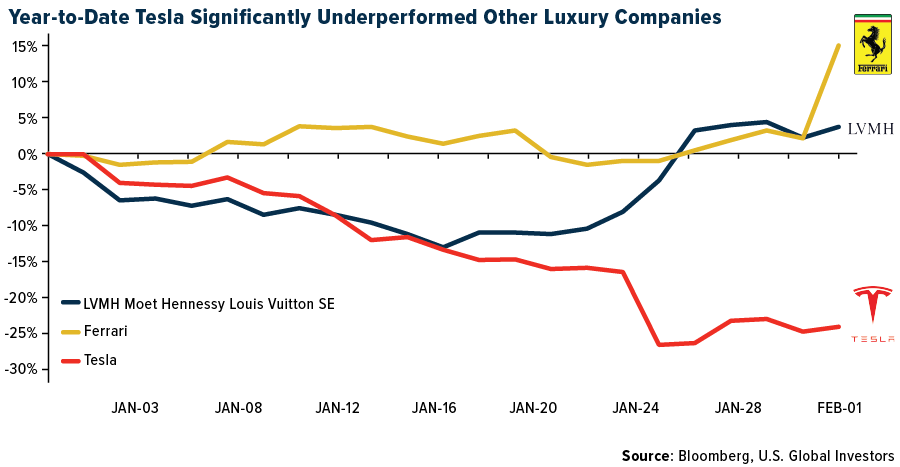
- The Federal Reserve left rates unchanged this week, indicating that is done raising rates but will not rush into cutting rates either, as inflation is still above the central bank’s target of 2%. During Fed Chair Jerome Powell’s news conference, he said policymakers are waiting to see additional data to verify that the trends are continuing. He also noted that a March rate cut is unlikely.
- The Financial Times reports how the January PMI survey reveals supply chain disruption for European producers due to Houthi attacks in the Red Sea. Major economies including Germany, France, Italy, and Greece face increasing shipping costs and supply issues due to the conflict in the region. This situation has the potential to contribute to an upward pressure on inflation rates.

Energy and Natural Resources
Strengths
- The best performing commodity for the week was uranium, as proxied by the Sprott Physical Uranium Trust, gaining 13.36%. The price surge following last week’s price correction was fueled by a potential production shortfall from NAC Kazatomprom, the world’s largest uranium producer, which warned that its 2025 production plans could get delayed as construction is behind and they are encountering difficulties in obtaining sulfuric acid, which is used for isolating the heavy metal, reports Bloomberg.
- Shares of Contemporary Amperex Technology, a leading Chinese battery manufacturer, surged this week after the Company posted a jump in full-year earnings, reports Bloomberg, allaying investor concerns that profitability could be waning.
- Both Exxon and Chevron blew through earnings forecasts, as bigger-than-expected oil output from their shale-based assets offset the decline in crude oil prices. Exxon’s trading unit delivered handsomely, reaping more than $1 billion in gains that more than offset the $410 million hit inflicted by lower crude prices. The strategy is a departure for a company that historically shunned trading as too risky and outside its traditional areas of expertise, explains Bloomberg.
Weaknesses
- Oil had no incentive to advance this week and finished Friday off 7.47%. Talks of a possible pause to the Israel-Hamas war reduced crude’s geopolitical risk premium, with the decline accelerating after crude slipped below key technical levels. There are also adequate inventories of crude on the sidelines, yet there is the incentive to raise production volumes to counter the decline in price. OPEC+’s pledge to cut production this quarter does not support oil’s move below its 200-day and 50-day moving averages this week.
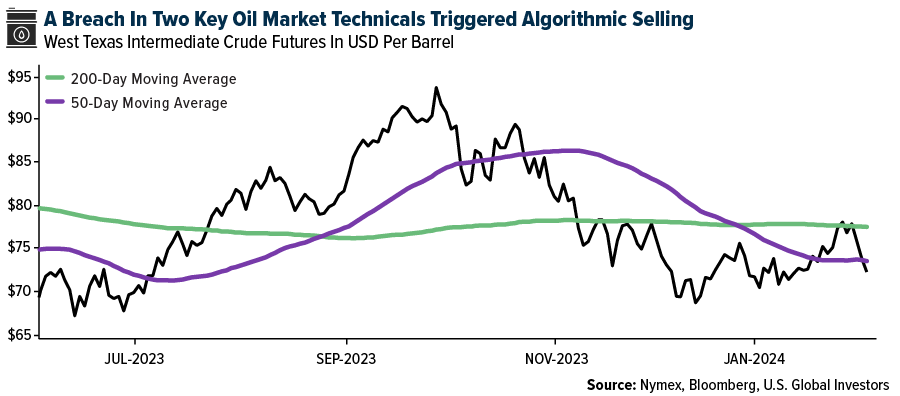
- Glencore Plc is reducing its cobalt production target for the year by up to 42% from its previous goal, attributing the cut to weak market conditions and the necessity to stockpile unsellable cobalt, leading to increased production costs, especially in copper mining. The adjustment in production, along with a decrease in copper and zinc output, underlines challenges in the cobalt market, intensified by rising supply and a slump in demand from the electric vehicle and consumer electronics sectors.
- Investors quickly sold off Braskem SA’s debt after its salt mine collapse in Brazil, which led to massive evacuations in the city of Maceio. However, the prices soon rebounded, highlighting a recurring pattern of short-lived financial repercussions for environmental disasters in Brazil. This trend raises questions about the effectiveness of environmental, social, and governance (ESG) standards in responsible investing.
Opportunities
- Britain has granted 24 new licenses to major oil companies, including Shell and BP, for drilling in the North Sea, aiming to bolster its ageing oil and gas sector despite fierce criticism for undermining climate commitments and overstating economic benefits. This move, part of an ongoing effort to maximize North Sea oil and gas extraction, has sparked backlash from environmentalists and MPs, who argue it jeopardizes the UK’s climate leadership and fails to address energy security or reduce energy bills effectively.
- Arianne Phosphate, a phosphate mining company, is initiating a Prefeasibility Study to build a purified phosphoric acid plant in Quebec, aiming to transform its high-purity phosphate into a finished product and become a key player in specialty markets including battery production. This move, aligned with growing global demand for purified phosphoric acid in lithium-iron-phosphate batteries, positions Arianne to significantly contribute to Western supply chains, currently dominated by China.
- A South Korean state-run company, holding a 10% stake in the $10 billion Cobre Panama copper mine, is considering legal action against the Panamanian government following the mine’s closure last year, reports Bloomberg. The decision for legal representation will be made in February, potentially leading to a lengthy international arbitration battle between the involved companies and Panama. Perhaps the government will reverse its decision to close the mine, given the foregone economic activity this action will cost.
Threats
- Two of China’s largest lithium companies, Tianqi Lithium Corp and Gangfeng Lithium Corp have issued warnings about significant profit declines, up to 73% and 80%, respectively, due to falling lithium prices. Meanwhile, shares in Chinese battery giant CATL surged after reporting increased full-year earnings, and attention is now turning to North American lithium-related stocks like Piedmont Lithium, Albemarle, Livent, SQM, and Lithium Americas.
- Nassim Nicholas Taleb, the author of “Black Swan,” warned that the ever-increasing U.S. deficit is heading toward an irreversible debt spiral, exacerbated by political unwillingness to address the issue. He described the mounting debt as a highly probable ‘white swan’ event, a significant risk in an increasingly interconnected global economy, echoing concerns of other financial experts about the potential global implications.
- Business groups from the U.S., Europe, and Japan have urged President Biden to resume licensing for new liquefied natural gas (LNG) export facilities, arguing that global demand for natural gas will continue to rise and can be met with emissions reductions. The U.S. Energy Department has paused approvals to assess LNG exports’ impact on climate change, the economy, and national security, amid concerns that expanding LNG infrastructure may lock in fossil fuel use for generations.
Bitcoin and Digital Assets
Strengths
- Of the cryptocurrencies tracked by CoinMarketCap, the best performer for the week was Ronin, rising 35.54%.
- Bitcoin is on course to advance for a fifth straight month in what would be the token’s longest such winning streak since a pandemic-era rally oiled by easy money. A run of five straight monthly gains would be the longest since a six-month stretch spanning October 2020 to March 2021, writes Bloomberg.
- Hong Kong will launch a consultation very soon on the proposed regulatory framework for over-the-counter venues applied in virtual assets, Secretary of Financial Services and the Treasury Christopher Hui said, and published by Bloomberg.
Weaknesses
- Of the cryptocurrencies tracked by CoinMarketCap, the worst performer for the week was Jupiter, down 61.60%.
- Binance Holdings’ efforts to re-enter the UK market are being frustrated by reluctance among prospective local partners to work with the world’s biggest cryptocurrency exchange amid regulatory opposition, writes Bloomberg.
- The U.S. Justice Department announced charges against individuals for orchestrating at $1.89 billion cryptocurrency fraud scheme, according to a statement. “The defendants falsely represented that investors would receive substantial returns paid from cryptocurrency mining operations which did not in fact exist,” according to an Attorney General, writes Bloomberg.
Opportunities
- The U.S. Securities and Exchange Commission is likely to allow exchange traded funds (ETFs) to hold the cryptocurrency Ethereum in May. Standard Chartered expects the SEC to rule on the application on the final date, which could lead to Ethereum climbing up to $4,000.
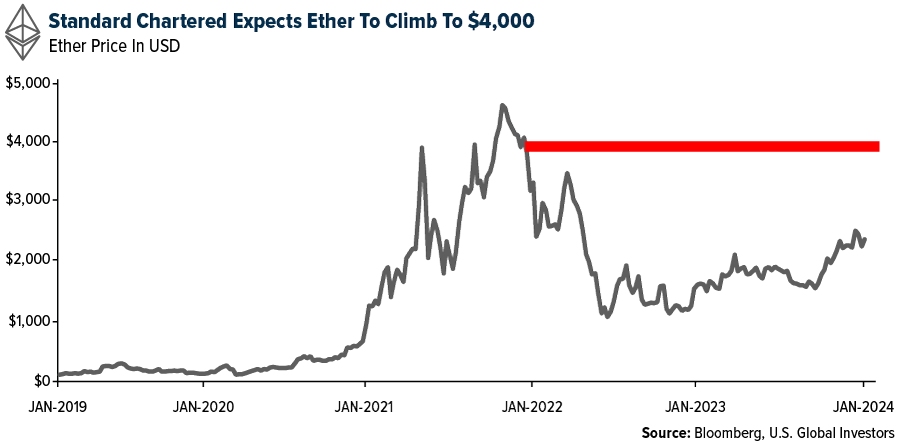
- GSR, one of crypto’s oldest market makers, named former JPMorgan Chase & Co. executive Andreas Koukorinis as head of trading, reports Bloomberg, as the company seeks to expand its liquidity operations and services offered to traditional financial firms.
- Demand for Bitcoin futures has eased following the U.S. debut of ETFs that directly hold the largest asset. Outstanding contracts form CME group Bitcoin futures dropped some 24% to 20,679 by January 30 after the 10 spot ETFs began trading three weeks ago, writes Bloomberg.
Threats
- German prosecutors provisionally seized nearly 50,000 Bitcoin worth about $2.1 billion as part of an investigation into what they see as an illegal file-sharing platform. It’s the largest amount of Bitcoin ever secured by law enforcement in Germany, according to an article published by Bloomberg.
- Somesing, a blockchain-based social karaoke platform in South Korea, suffered an exploit on Saturday and lost 730 million of its native token SSX, which amounts to $11.58 million. The platform reported to the National Police Agency for an investigation into the hacking incident and said it will alert Interpol, writes Bloomberg.
- A Manhattan jury on Thursday found an Upper East side women guilty of funding terrorism after she used cryptocurrency to send financial support to several groups operating in Syria, writes Bloomberg.

Gold Market
This week gold futures closed at $2,053.70, up $17.60 per ounce, or 0.86%. Gold stocks, as measured by the NYSE Arca Gold Miners Index, ended the week higher by 0.40%. The S&P/TSX Venture Index came in up 1.11%. The U.S. Trade-Weighted Dollar rose 0.47%.
Strengths
- The best performing precious metal for the week was gold, rising 0.86%. With the odds being roughly even that the Fed would start cutting interest rates at its next meeting in March, gold came out of the gate on Monday well bid. Initial jobless claims released on Thursday were largely as expected, further boosting the hope for rate cuts even though Jerome Powell stated Wednesday that there is probably not enough new data between now and March to give the Fed the confidence to start cutting. Friday’s blowout Change in Nonfarm Payrolls showed very strong growth in the job market, taking some of the shine off gold at the end of the week.
- Franco-Nevada Corp., one of the leading gold royalty and streaming companies, announced the rise of its quarterly dividend. The dividend, payable on March 28, 2024, was increased by 5.88% to USD 0.36 per share. The increase will be effective for the 2024 fiscal year and is the 17th consecutive annual increase made by the company, reports Simply Wall St.
- According to Bloomberg, gold jewelry consumption in 2023 was 2,093 tons. The demand in India, the second biggest consumer, is expected to rebound to around 800-900 tons in the next two years after a slight decline in 2023 to 748 tons. This expected increase in demand is supported by rising incomes and evidence that despite the high prices, sales remained the same in the previous years. In China, the demand for gold jewelry is expected to remain stable.
Weaknesses
- The worst performing precious metal for the week was palladium, falling 1.08%, largely in line with all of the industrial metals which ended the week lower. Gold Fields Ltd. was cut to underperform on Friday and the share price dropped nearly 10% in value. Analyst Raj Ray cited potential negative read through from the Gruyere asset, which Gold Fields has a 50:50 JV with Gold Road, which reported a weaker-than-expected 2024 forecast. Ray noted the other Australian assets are all development intensive underground mines, thus the stock should not be trading above its peers on comparable financial metrics.
- According to a January 31 report from the World Gold Council (WGC), global gold ETFs saw a third consecutive annual outflow, losing 244t. The pace of outflows slowed markedly into year-end, the group explains, but October’s hefty outflows dominated the fourth quarter picture. On a positive note, annual jewelry consumption held steady at 2,093t, even in the very high gold price environment.
- According to Bloomberg and Swiss Federal Customs Administration data, Swiss gold shipments decreased to 107.9 tons in December from 109.7 tons in November. At the same time, gold exports to India fell 51% to 8.1 tons, and to Hong Kong they fell 67% to 6.5 tons. Sales to Turkey decreased 8% to 8.1 tons, and Swiss gold imports dropped 15% to 143.7 tons.
Opportunities
- According to data from the World Gold Council (WGC) and Bloomberg, gold demand hit a record last year and is expected to keep the trend in 2024. The overall consumption of the yellow metal increased by about 3% to 4,899 tons last year, backed by solid demand in the opaque over-the-counter market (OTC) and buying by central banks worldwide, especially in China and Poland. The annual demand in the OTC market hit 753% in 2023, the highest since 2011, according to WGC data.
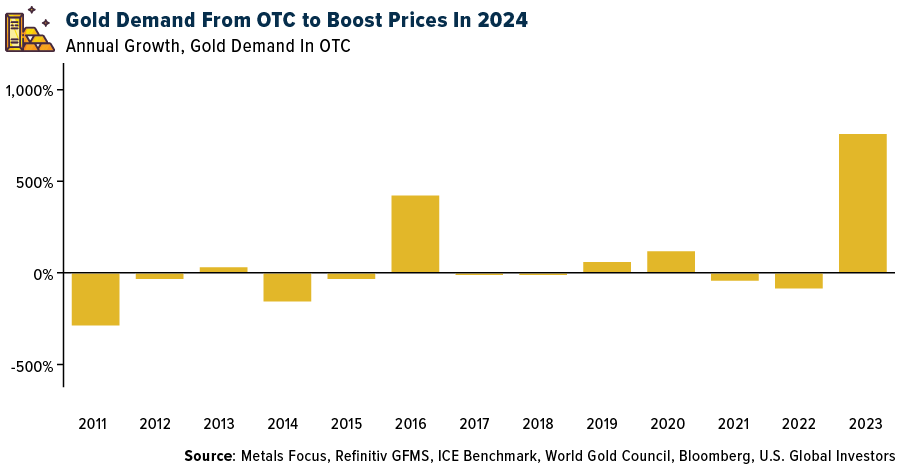
- Despite last week’s first weekly fall, following a month of gains, gold is back in the spotlight with the sudden uptick in concerns over banks’ balance sheets, as they are facing $560 billion in commercial real estate maturities coming due by the end of 2025. The wakeup call came from New York Community Bancorp and Japan’s Aozora Bank Ltd. Bancorp slashed its dividend and will stockpile reserves sending the share price down 38% for the day, a 23-year low. Aozora warned investors on U.S. commercial property losses, and its share price dropped 20%. Office properties are the most underwater, as reported by Bloomberg.
- The Chinese Lunar New Year kicks off next weekend, and many luxury brands are already crafting themed products to celebrate, reports Bloomberg, many of which incorporate gold. For example, Louis Vuitton’s red lacquered box has trunk-style gold corners and is topped with a hard carved wooden dragon. Then there is John Hardy’s Naga collection, featuring jewelry with dragonheads. The Naga Lariat, Bloomberg explains, is crafted from 14K gold and White diamond accents.
Threats
- Pandora, the world’s largest jeweler by amount of products sold, has stopped using mined silver and gold, reports Reuters, and now only manufacturers with recycled precious metals – which require less energy to produce. Using recycled, instead of newly mined, metals cuts Pandora’s indirect CO2 emissions by around 58,000 tonnes annually, said Mads Twomey-Madsen, its senior vice president of communications and sustainability.
- The U.S. government will rescind the license awarded to Venezuela’s state gold producer, issued in October 2023. This license was banned in 2019 to prevent lucrative sales that kept the military loyal to the Maduro government. The measure is the result of Maduro’s government’s action to prohibit the participation of the opposition’s leading candidate, Maria Corina Machado, from participating in elections this year. The U.S. government is also considering additional measures, according to Bloomberg.
- According to the latest World Gold Council report, in the fourth quarter of 2023, central banks bought 229 metric tons of gold, representing a decrease when compared to the 382 tons in the year-ago quarter in 2022. Gold buying over the entire year declined by about 4%, from 1,082 tons in 2022 to 1,037 tons in 2023. Even if there is a slight decrease, this could impact buyers’ perceptions, considering that the gold consumer behavior of global central banks has a significant influence on the reaction of the gold market worldwide.
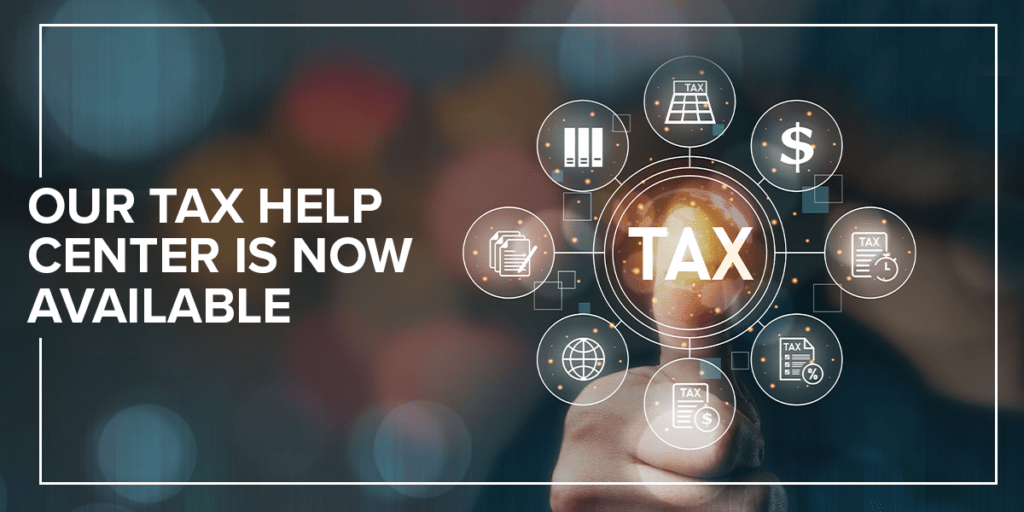

U.S. Global Investors, Inc. is an investment adviser registered with the Securities and Exchange Commission (“SEC”). This does not mean that we are sponsored, recommended, or approved by the SEC, or that our abilities or qualifications in any respect have been passed upon by the SEC or any officer of the SEC.
This commentary should not be considered a solicitation or offering of any investment product. Certain materials in this commentary may contain dated information. The information provided was current at the time of publication. Some links above may be directed to third-party websites. U.S. Global Investors does not endorse all information supplied by these websites and is not responsible for their content. All opinions expressed and data provided are subject to change without notice. Some of these opinions may not be appropriate to every investor.
Holdings may change daily. Holdings are reported as of the most recent quarter-end. The following securities mentioned in the article were held by one or more accounts managed by U.S. Global Investors as of (12/31/2023):
American Airlines
easyJet PLC
Sun Country Airlines
Maersk
Delta Air Lines
Japan Airlines
Arianne Phosphate
Ferrari
Royal Caribbean
LVMH
Ivanhoe Mines Ltd.
Franco-Nevada Corp.
Gold Fields
Gold Road Resources
*The above-mentioned indices are not total returns. These returns reflect simple appreciation only and do not reflect dividend reinvestment.
The Dow Jones Industrial Average is a price-weighted average of 30 blue chip stocks that are generally leaders in their industry. The S&P 500 Stock Index is a widely recognized capitalization-weighted index of 500 common stock prices in U.S. companies. The Nasdaq Composite Index is a capitalization-weighted index of all Nasdaq National Market and SmallCap stocks. The Russell 2000 Index® is a U.S. equity index measuring the performance of the 2,000 smallest companies in the Russell 3000®, a widely recognized small-cap index.
The Hang Seng Composite Index is a market capitalization-weighted index that comprises the top 200 companies listed on Stock Exchange of Hong Kong, based on average market cap for the 12 months. The Taiwan Stock Exchange Index is a capitalization-weighted index of all listed common shares traded on the Taiwan Stock Exchange. The Korea Stock Price Index is a capitalization-weighted index of all common shares and preferred shares on the Korean Stock Exchanges.
The Philadelphia Stock Exchange Gold and Silver Index (XAU) is a capitalization-weighted index that includes the leading companies involved in the mining of gold and silver. The U.S. Trade Weighted Dollar Index provides a general indication of the international value of the U.S. dollar. The S&P/TSX Canadian Gold Capped Sector Index is a modified capitalization-weighted index, whose equity weights are capped 25 percent and index constituents are derived from a subset stock pool of S&P/TSX Composite Index stocks. The NYSE Arca Gold Miners Index is a modified market capitalization weighted index comprised of publicly traded companies involved primarily in the mining for gold and silver. The S&P/TSX Venture Composite Index is a broad market indicator for the Canadian venture capital market. The index is market capitalization weighted and, at its inception, included 531 companies. A quarterly revision process is used to remove companies that comprise less than 0.05% of the weight of the index, and add companies whose weight, when included, will be greater than 0.05% of the index.
The S&P 500 Energy Index is a capitalization-weighted index that tracks the companies in the energy sector as a subset of the S&P 500. The S&P 500 Materials Index is a capitalization-weighted index that tracks the companies in the material sector as a subset of the S&P 500. The S&P 500 Financials Index is a capitalization-weighted index. The index was developed with a base level of 10 for the 1941-43 base period. The S&P 500 Industrials Index is a Materials Index is a capitalization-weighted index that tracks the companies in the industrial sector as a subset of the S&P 500. The S&P 500 Consumer Discretionary Index is a capitalization-weighted index that tracks the companies in the consumer discretionary sector as a subset of the S&P 500. The S&P 500 Information Technology Index is a capitalization-weighted index that tracks the companies in the information technology sector as a subset of the S&P 500. The S&P 500 Consumer Staples Index is a Materials Index is a capitalization-weighted index that tracks the companies in the consumer staples sector as a subset of the S&P 500. The S&P 500 Utilities Index is a capitalization-weighted index that tracks the companies in the utilities sector as a subset of the S&P 500. The S&P 500 Healthcare Index is a capitalization-weighted index that tracks the companies in the healthcare sector as a subset of the S&P 500. The S&P 500 Telecom Index is a Materials Index is a capitalization-weighted index that tracks the companies in the telecom sector as a subset of the S&P 500.
The Consumer Price Index (CPI) is one of the most widely recognized price measures for tracking the price of a market basket of goods and services purchased by individuals. The weights of components are based on consumer spending patterns. The Purchasing Manager’s Index is an indicator of the economic health of the manufacturing sector. The PMI index is based on five major indicators: new orders, inventory levels, production, supplier deliveries and the employment environment. Gross domestic product (GDP) is the monetary value of all the finished goods and services produced within a country’s borders in a specific time period, though GDP is usually calculated on an annual basis. It includes all private and public consumption, government outlays, investments and exports less imports that occur within a defined territory.
The S&P Global Luxury Index is comprised of 80 of the largest publicly traded companies engaged in the production or distribution of luxury goods or the provision of luxury services that meet specific investibility requirements.































